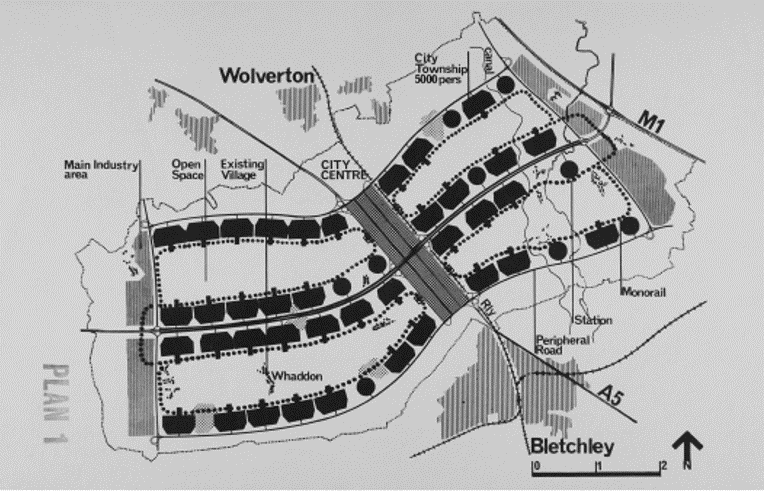Social Planning and Market Research
The post-Second World War period provided new opportunities for those with social-scientific training to participate in ‘planning’: from individual housing developments and slum clearance, to entirely ‘new’ towns. At the same time, commercial interests began to use these methods to identify new consumer bases and product demand. At the centre of this was a research process known as the 'social survey' which Mark Abrams defined as 'a process by which quantitative facts are collected about the social aspects of a community's composition and activities' (Social Surveys and Social Action, p. 1). These methods also gave rise to the opinion poll and various forms of market research. Given its integral nature to post-war planning (and the fact that Mass-Observation, which we met in the previous week, was eventually sold off to a market research company), in this week's seminar we will engage with these issues to see where this planning emerged from and what happened to it.
Readings
Laura Dumond Beers, ‘Whose opinion? Changing attitudes towards opinion polling in British politics, 1937-1964’, Twentieth Century British History, 17:2 (2006), pp. 177-205
Matthew Hollow, 'Governmentality on the Park Hill Estate: the rationality of public housing', Urban History, 37:1 (2010), pp. 117-135
Joe Moran, 'Mass-Observation, market research, and the birth of the focus group, 1937–1997', Journal of British Studies, 47 (2008), pp. 827-851
Daniel O'Neill, '"People love Player's": cigarette advertising and the teenage consumer in post-war Britain', Twentieth Century British History, 28:3 (2017), pp. 414-439
Guy Ortolano, Thatcher's Progress: from social democracy to market liberalism through an English New Town (Cambridge: CUP, 2019), chapter 4, 'Community', pp. 143-183
Mike Savage, Identities and Social Change in Britain since 1940: the politics of method (Oxford: OUP, 2010), chapter 8, '1941: the sample survey and the modern rational nation', pp. 187-212
Mark Abrams
This week's main primary source base focuses on the work of the pioneering market researcher and social surveyor Mark Abrams (1906-1994):
Abrams, The Condition of the British People, 1911-1945: a study prepared for the Fabian Society (London: Gollancz, 1946)
- 'The Growth of the Suburbs' and 'Families', pp. 34-43
- 'The Pattern of Poverty', pp. 95-108
Abrams, Social Surveys and Social Action (London: Heinemann, 1951)
- 'Portrait of a Survey', pp. 5-18
- 'The Borrowers I: Market Research', pp. 53-62
- 'The Borrowers II: Public Opinion Surveys', pp. 63-80
- as a bonus: descriptions of some 'recent' studies and Abrams' thoughts on Mass-Observation! (from the chapter, 'Developments in Britain since 1939')
Abrams, The Teenage Consumer (London: London Press Exchange, 1959)
- A fascinating pamphlet with some great illustrations!
Abrams, Richard Rose and Rita Hinden, Must Labour Lose? (Harmondsworth: Penguin, 1960)
- 'Young Voters', pp. 47-58
Abrams, The Newspaper Reading Public of Tomorrow (London: Odhams Press, 1964)
- 'The Use of Leisure', pp. 43-51
- 'Age Instead of Class', pp. 57-64
Seminar questions
-
What were the main research interests of post-war market research?
-
Where did market research emerge from?
-
How did age, gender and class factor into post-war analyses of consumption, leisure and housing?
-
How far were opinion polls/social surveys/market research measuring social reality and to what extent were they actively constructing it?
New Society dossier
E.M. Eppel and M. Eppel, 'Teenage values', 14 November 1963 [PDF]
John Barr, 'What kind of homes do people want?', 11 November 1965 [PDF]
Joan Rockwell, 'A self-portrait of Danish teenagers', 12 February 1970 [PDF]
'Adolescent violence', 13 December 1973 [PDF]
Roger Kitchen, 'Moving to Milton Keynes', 22 August 1974 [PDF]
Bernard Davies, 'The life of adolescence', 20 March 1975 [PDF]
Jane Morton, 'Life styles of the young', 22-29 December 1977 [PDF]
Alan Ryan, 'The slow death of Labour England', 16 June 1983 [PDF]
Noelle Baldari, 'An estate of crisis', 27 February 1987 [PDF]
Adriana Caudrey, 'A taste of the polls?', 22 May 1987 [PDF]
Adrian Furnham, 'The ways of the young', 8 January 1988 [PDF]
Further reading
Vernon Bogdanor and Robert Skidelsky (eds), The Age of Affluence, 1951-1964 (London: Macmillan, 1970)
Christine Grandy, 'Cultural history's absent audience', Cultural and Social History, 16:5 (2019), pp. 643-663
Stuart Middleton, '"Affluence" and the left in Britain, c.1958-1974', English Historical Review, 536 (2014), pp. 107-138
Frank Mort, 'Boys own? Masculinity, style and popular culture', in Rowena Chapman and Jonathan Rutherford (eds), Male Order: unwrapping masculinity (London: Lawrence & Wishart, 1988), pp. 193-224
Frank Mort, Cultures of Consumption: masculinities and social space in late twentieth-century Britain (London: Routledge, 1996)
Sean Nixon, ‘Mrs Housewife and the Ad Men: advertising, market research, and mass consumption in postwar Britain’, in Hartmut Berghoff, Philip Scranton and Uwe Spiekermann (eds), The Rise of Marketing and Market Research (Basingstoke: Palgrave Macmillan, 2012), pp. 93-194.
Billy Smart, 'The BBC Television Audience Research Reports, 1957-1979: recorded opinions and invisible expectations', Historical Journal of Film, Radio and Television , 34:3 (2014), pp. 452-462
Melanie Tebbutt, 'Listening to youth? BBC youth broadcasts during the 1930s and the Second World War', History Workshop, 84 (2017), pp. 214-233
Selina Todd and Hilary Young, 'Baby-boomers to "beanstalkers": making the modern teenager in post-war Britain', Cultural and Social History, 9:3 (2012), pp. 451-467
Sam Wetherell, Foundations: how the built environment made twentieth-century Britain (Princeton: Princeton University Press, 2020)
For anyone interested in audience research and TV/cinema, please see the further resources in week 9.

Top: Early concept for 'Bucks New Town' (what would become Milton Keynes). See: Guy Ortolano, Thatcher's Progress, p. 36.
Bottom: Park Hill estate, Sheffield (see Hollow reading).
